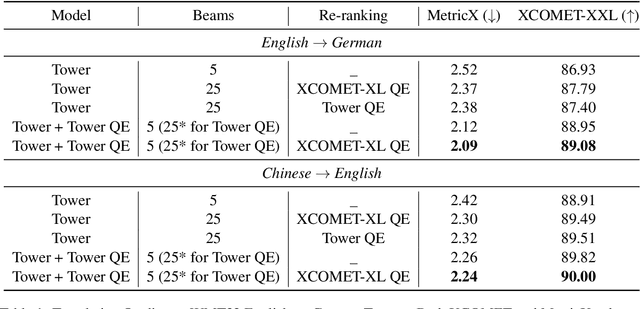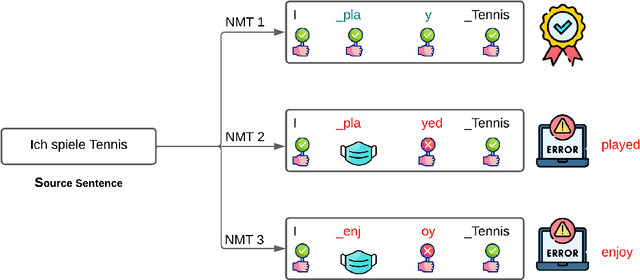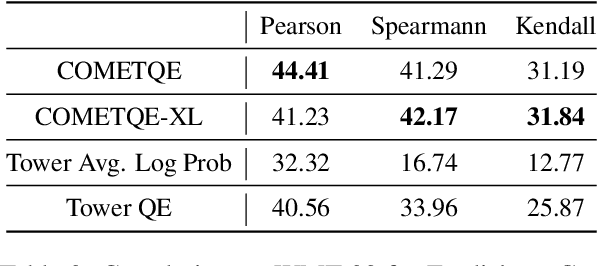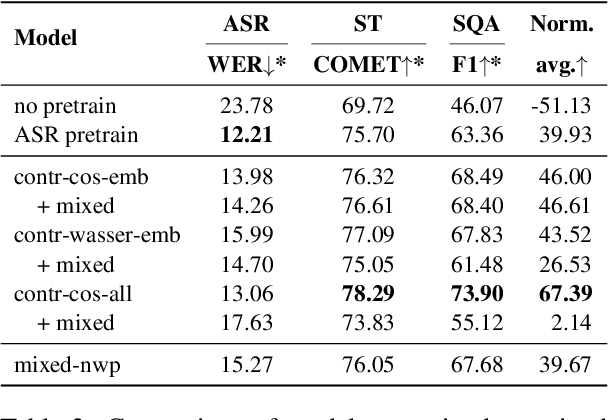Jan Niehues
Knockout LLM Assessment: Using Large Language Models for Evaluations through Iterative Pairwise Comparisons
Jun 05, 2025Abstract:Large Language Models (LLMs) have shown to be effective evaluators across various domains such as machine translations or the scientific domain. Current LLM-as-a-Judge approaches rely mostly on individual assessments or a single round of pairwise assessments, preventing the judge LLM from developing a global ranking perspective. To address this, we present Knockout Assessment, an LLM-asa Judge method using a knockout tournament system with iterative pairwise comparisons. Experiments across three LLMs on two datasets show that knockout assessment improves scoring accuracy, increasing Pearson correlation with expert evaluations by 0.07 on average for university-level exam scoring and machine translation evaluations, aligning LLM assessments more closely with human scoring.
In-context Language Learning for Endangered Languages in Speech Recognition
May 28, 2025Abstract:With approximately 7,000 languages spoken worldwide, current large language models (LLMs) support only a small subset. Prior research indicates LLMs can learn new languages for certain tasks without supervised data. We extend this investigation to speech recognition, investigating whether LLMs can learn unseen, low-resource languages through in-context learning (ICL). With experiments on four diverse endangered languages that LLMs have not been trained on, we find that providing more relevant text samples enhances performance in both language modelling and Automatic Speech Recognition (ASR) tasks. Furthermore, we show that the probability-based approach outperforms the traditional instruction-based approach in language learning. Lastly, we show ICL enables LLMs to achieve ASR performance that is comparable to or even surpasses dedicated language models trained specifically for these languages, while preserving the original capabilities of the LLMs.
KIT's Low-resource Speech Translation Systems for IWSLT2025: System Enhancement with Synthetic Data and Model Regularization
May 26, 2025Abstract:This paper presents KIT's submissions to the IWSLT 2025 low-resource track. We develop both cascaded systems, consisting of Automatic Speech Recognition (ASR) and Machine Translation (MT) models, and end-to-end (E2E) Speech Translation (ST) systems for three language pairs: Bemba, North Levantine Arabic, and Tunisian Arabic into English. Building upon pre-trained models, we fine-tune our systems with different strategies to utilize resources efficiently. This study further explores system enhancement with synthetic data and model regularization. Specifically, we investigate MT-augmented ST by generating translations from ASR data using MT models. For North Levantine, which lacks parallel ST training data, a system trained solely on synthetic data slightly surpasses the cascaded system trained on real data. We also explore augmentation using text-to-speech models by generating synthetic speech from MT data, demonstrating the benefits of synthetic data in improving both ASR and ST performance for Bemba. Additionally, we apply intra-distillation to enhance model performance. Our experiments show that this approach consistently improves results across ASR, MT, and ST tasks, as well as across different pre-trained models. Finally, we apply Minimum Bayes Risk decoding to combine the cascaded and end-to-end systems, achieving an improvement of approximately 1.5 BLEU points.
KIT's Offline Speech Translation and Instruction Following Submission for IWSLT 2025
May 19, 2025Abstract:The scope of the International Workshop on Spoken Language Translation (IWSLT) has recently broadened beyond traditional Speech Translation (ST) to encompass a wider array of tasks, including Speech Question Answering and Summarization. This shift is partly driven by the growing capabilities of modern systems, particularly with the success of Large Language Models (LLMs). In this paper, we present the Karlsruhe Institute of Technology's submissions for the Offline ST and Instruction Following (IF) tracks, where we leverage LLMs to enhance performance across all tasks. For the Offline ST track, we propose a pipeline that employs multiple automatic speech recognition systems, whose outputs are fused using an LLM with document-level context. This is followed by a two-step translation process, incorporating additional refinement step to improve translation quality. For the IF track, we develop an end-to-end model that integrates a speech encoder with an LLM to perform a wide range of instruction-following tasks. We complement it with a final document-level refinement stage to further enhance output quality by using contextual information.
From Speech to Summary: A Comprehensive Survey of Speech Summarization
Apr 10, 2025Abstract:Speech summarization has become an essential tool for efficiently managing and accessing the growing volume of spoken and audiovisual content. However, despite its increasing importance, speech summarization is still not clearly defined and intersects with several research areas, including speech recognition, text summarization, and specific applications like meeting summarization. This survey not only examines existing datasets and evaluation methodologies, which are crucial for assessing the effectiveness of summarization approaches but also synthesizes recent developments in the field, highlighting the shift from traditional systems to advanced models like fine-tuned cascaded architectures and end-to-end solutions.
NUTSHELL: A Dataset for Abstract Generation from Scientific Talks
Feb 24, 2025Abstract:Scientific communication is receiving increasing attention in natural language processing, especially to help researches access, summarize, and generate content. One emerging application in this area is Speech-to-Abstract Generation (SAG), which aims to automatically generate abstracts from recorded scientific presentations. SAG enables researchers to efficiently engage with conference talks, but progress has been limited by a lack of large-scale datasets. To address this gap, we introduce NUTSHELL, a novel multimodal dataset of *ACL conference talks paired with their corresponding abstracts. We establish strong baselines for SAG and evaluate the quality of generated abstracts using both automatic metrics and human judgments. Our results highlight the challenges of SAG and demonstrate the benefits of training on NUTSHELL. By releasing NUTSHELL under an open license (CC-BY 4.0), we aim to advance research in SAG and foster the development of improved models and evaluation methods.
Middle-Layer Representation Alignment for Cross-Lingual Transfer in Fine-Tuned LLMs
Feb 20, 2025Abstract:While large language models demonstrate remarkable capabilities at task-specific applications through fine-tuning, extending these benefits across diverse languages is essential for broad accessibility. However, effective cross-lingual transfer is hindered by LLM performance gaps across languages and the scarcity of fine-tuning data in many languages. Through analysis of LLM internal representations from over 1,000+ language pairs, we discover that middle layers exhibit the strongest potential for cross-lingual alignment. Building on this finding, we propose a middle-layer alignment objective integrated into task-specific training. Our experiments on slot filling, machine translation, and structured text generation show consistent improvements in cross-lingual transfer, especially to lower-resource languages. The method is robust to the choice of alignment languages and generalizes to languages unseen during alignment. Furthermore, we show that separately trained alignment modules can be merged with existing task-specific modules, improving cross-lingual capabilities without full re-training. Our code is publicly available (https://github.com/dannigt/mid-align).
Early-Exit and Instant Confidence Translation Quality Estimation
Feb 20, 2025Abstract:Quality estimation is omnipresent in machine translation, for both evaluation and generation. Unfortunately, quality estimation models are often opaque and computationally expensive, making them impractical to be part of large-scale pipelines. In this work, we tackle two connected challenges: (1) reducing the cost of quality estimation at scale, and (2) developing an inexpensive uncertainty estimation method for quality estimation. To address the latter, we introduce Instant Confidence COMET, an uncertainty-aware quality estimation model that matches the performance of previous approaches at a fraction of their costs. We extend this to Early-Exit COMET, a quality estimation model that can compute quality scores and associated confidences already at early model layers, allowing us to early-exit computations and reduce evaluation costs. We also apply our model to machine translation reranking. We combine Early-Exit COMET with an upper confidence bound bandit algorithm to find the best candidate from a large pool without having to run the full evaluation model on all candidates. In both cases (evaluation and reranking) our methods reduce the required compute by 50% with very little degradation in performance.
Quality-Aware Decoding: Unifying Quality Estimation and Decoding
Feb 12, 2025



Abstract:An emerging research direction in NMT involves the use of Quality Estimation (QE) models, which have demonstrated high correlations with human judgment and can enhance translations through Quality-Aware Decoding. Although several approaches have been proposed based on sampling multiple candidate translations, none have integrated these models directly into the decoding process. In this paper, we address this by proposing a novel token-level QE model capable of reliably scoring partial translations. We build a uni-directional QE model for this, as decoder models are inherently trained and efficient on partial sequences. We then present a decoding strategy that integrates the QE model for Quality-Aware decoding and demonstrate that the translation quality improves when compared to the N-best list re-ranking with state-of-the-art QE models (upto $1.39$ XCOMET-XXL $\uparrow$). Finally, we show that our approach provides significant benefits in document translation tasks, where the quality of N-best lists is typically suboptimal.
Contrastive Learning for Task-Independent SpeechLLM-Pretraining
Dec 20, 2024



Abstract:Large language models (LLMs) excel in natural language processing but adapting these LLMs to speech processing tasks efficiently is not straightforward. Direct task-specific fine-tuning is limited by overfitting risks, data requirements, and computational costs. To address these challenges, we propose a scalable, two-stage training approach: (1) A task-independent speech pretraining stage using contrastive learning to align text and speech representations over all layers, followed by (2) a task-specific fine-tuning stage requiring minimal data. This approach outperforms traditional ASR pretraining and enables the model to surpass models specialized on speech translation and question answering while being trained on only 10% of the task-specific data.
 Add to Chrome
Add to Chrome Add to Firefox
Add to Firefox Add to Edge
Add to Edge